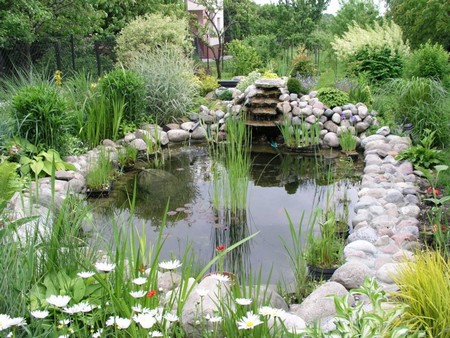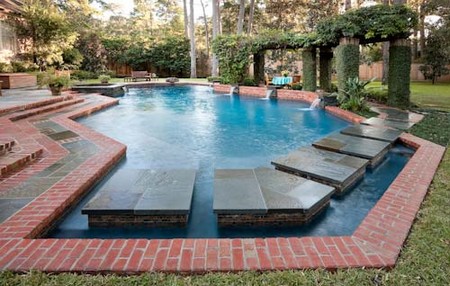Best Way to Build a Semi-Formal Pool Garden
The semi-formal pool garden is centred around two pools, which ate divided by a curving brick path and a bog garden. Having pools and a bog garden greatly extends the range of plants that can be grown and creates an attractive habitat for wildlife. Because of the rich diversity of plants there is a huge variety of textures and shapes, and despite the path that winds through the garden, the space feels positively enveloped by a cloak of greenery, making it a secluded hideaway from the neighbouring gardens.
Simplicity is the key to the success of the design, which is mirrored along a horizontal axis, with the shed complementing the shape of the steps and the pools mirroring each other. The gentle colours of the water are reflected in the foliage – calm greens, blues and greys are found among areas of lush greens. This is a garden that you will want to step into and explore. A small fountain combines movement and stillness to make a garden that is inviting and relaxing.
Features
The brick path extends from the house to the small brick shed in the far corner of the garden. In the sitting area the weathered bricks are laid herringbone-style, while the area beyond the first pool has been paved with straight small bricks. The stone slabs used as coping flow from one half to the other to tie the two areas together. The shallow step between the pools creates a subtle change of level without being dramatic and encourages visitors to pause to admire the plants.
The stillness of the water in the pools adds charm to the garden and reinforces the strong design. The water, reflecting both sky and foliage, will complement and emphasize the business of leaf movement and insect life in the garden.
A small raised bed in front of the shed elevates several small shrubs, which provide an effective screen in front of the structure, and the bed continues along the far side of the farther pool, offering additional space to grow a variety of stunning plants.
Semi-Formal Pool Garden
The brick walls have been painted white to create a bright, sunny garden and also to provide a good background against which the planting can be admired. Trellis is used on top of the three garden walls to increase the height without reducing light and to provide an extension of the growing area for plants. The wood of the trellis and of the steps leading to the sitting area is picked up by the table and chairs.
Planting
A huge range of plants has been used, but there is still plenty of room for a spacious area for sitting out because most of the planting is contained in beds at the bottom of the walls, leaving the central area clear and the shapes of the hard landscaping obvious. The beds allow the planting to continue unbroken all round the garden for seclusion and privacy. Architectural plants, such as Phormium tenax Aurora’, P. ‘Maori Chief and Doryanthes palmeri (spear lily), create focal points and add a range of heights but the main focus remains within the garden itself.
The clear edges of the pools at the path side, uncluttered by overhanging plants, emphasize the formality of the pools, which is, at the same time, offset by a diverse range of floating aquatic plants. Both pools have a lush background of plants, and a wide variety of foliage forms has been used to create diversity and interest. The miniature elegance of Typha minima (reedmace) and Iris ensata ‘Blue Peter’, backed by the strong architectural spikes of Yucca filamentosa ‘Bright Edge’, create a stunning effect at this point. Populus alba ‘Raket’ (poplar) adds rustling grey foliage to the barer part of the boundaty.
A bog garden offers the opportunity to grow plants particularly suited to this damp ground. Such an area is easily created by extending the pool liner into a depression, which can be filled with good quality soil.
Many of the aquatic plants are planted in containers to reduce their spread and maintenance. Once the balance of plant and insect life is established the pools should be self-sustaining and the water should remain clear, although regular checks for pests and weeds, such as blankerweed and pondweed, need to be kept up. Always remove any leaves that fall into the pool to prevent a build up of toxic gases released by the decaying process.
Categories
Advertisements
Recent Articles
 How to Understand Bed Sizes – A Small Guide
How to Understand Bed Sizes – A Small Guide How to Select Some Must Have Kitchen Accessories
How to Select Some Must Have Kitchen Accessories Best Way to Change a Car Tire
Best Way to Change a Car Tire Best Way to Write an Affirmation
Best Way to Write an Affirmation Best Way to Take Charge of Your Financial Life
Best Way to Take Charge of Your Financial Life Best Way to Survive a Party When You Don’t Know Anyone
Best Way to Survive a Party When You Don’t Know Anyone Best Way to Stop Self Sabotaging Yourself
Best Way to Stop Self Sabotaging Yourself Best Way to Start Journal Writing
Best Way to Start Journal Writing Best Way to Speak with a Powerful Voice
Best Way to Speak with a Powerful Voice Best Way to Simplify Your Life
Best Way to Simplify Your Life Best Way to Respond to a Put-Down
Best Way to Respond to a Put-Down Best Way to Reduce Acne Breakouts
Best Way to Reduce Acne Breakouts Best Way to Recover from Dining Disasters
Best Way to Recover from Dining Disasters Best Way to Quit Your Job Gracefully
Best Way to Quit Your Job Gracefully Best Way to Make Your Own Website
Best Way to Make Your Own Website



Leave a Reply